Java并发编程的艺术(5-10)学习总结
Posted 月亮的-影子
tags:
篇首语:本文由小常识网(cha138.com)小编为大家整理,主要介绍了Java并发编程的艺术(5-10)学习总结相关的知识,希望对你有一定的参考价值。
本文参考学习Java并发编程的艺术
第5章 Java中的锁
5.1 Lock接口
- synchronized没有的特性
- 尝试非阻塞获取锁
- 能够中断获取锁
- 超时获取锁

5.2 队列同步器
- 队列同步器AbstractQueuedSynchronizer用来构建锁,或者其它同步组件。用一个int成员变量表示同步状态。通过内置的FIFO队列完成资源获取线程的排队工作。
- 同步器的实现主要是继承,同步器需要提供(getState()、setState(int newState)和compareAndSetState(int expect,int update))方法来获取同步的状态。
- 同步器支持独占或者是共享地获取锁。
5.2.1 队列同步器的接口与示例
- 同步器的实现基于模板方法。继承并重写。
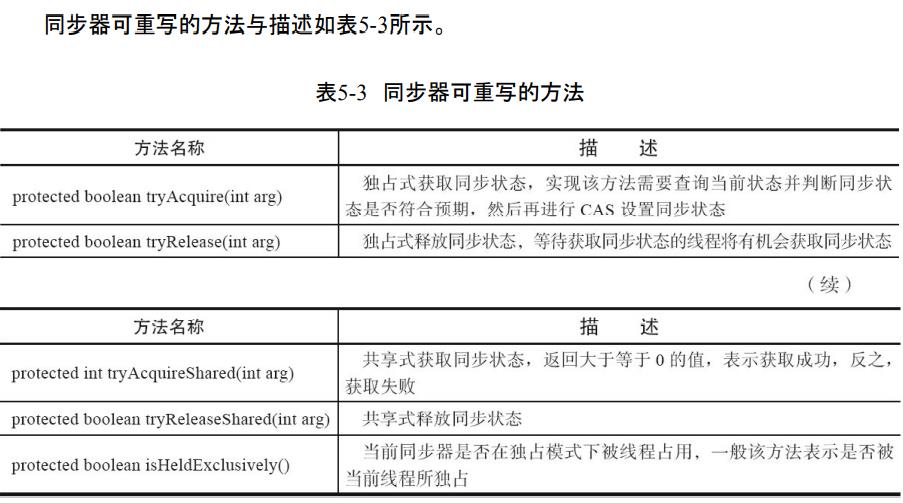
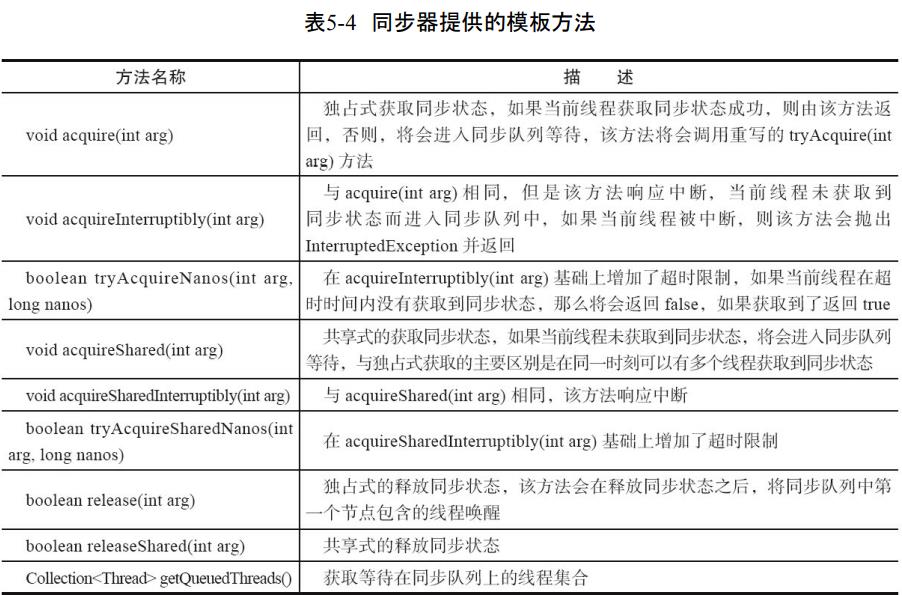
- 模板方法包括3类,独占式的获取和释放同步状态,共享式的获取和释放同步状态,查询同步队列的等待状态线程情况。
通过独占锁来说明情况
- 独占锁只能一个线程获取锁。其它线程只能进入到同步队列。
import java.util.concurrent.TimeUnit;
import java.util.concurrent.locks.AbstractQueuedSynchronizer;
import java.util.concurrent.locks.Condition;
class Mutex implements Lock
// 静态内部类,自定义同步器
private static class Sync extends AbstractQueuedSynchronizer
// 是否处于占用状态
protected boolean isHeldExclusively()
return getState() == 1;
// 当状态为0的时候获取锁
public boolean tryAcquire(int acquires)
if (compareAndSetState(0, 1))
setExclusiveOwnerThread(Thread.currentThread());
return true;
return false;
// 释放锁,将状态设置为0
protected boolean tryRelease(int releases)
if (getState() == 0) throw new
IllegalMonitorStateException();
setExclusiveOwnerThread(null);
setState(0);
return true;
// 返回一个Condition,每个condition都包含了一个condition队列
Condition newCondition() return new ConditionObject();
// 仅需要将操作代理到Sync上即可
private final Sync sync = new Sync();
public void lock() sync.acquire(1);
public boolean tryLock() return sync.tryAcquire(1);
public void unlock() sync.release(1);
public Condition newCondition() return sync.newCondition();
public boolean isLocked() return sync.isHeldExclusively();
public boolean hasQueuedThreads() return sync.hasQueuedThreads();
public void lockInterruptibly() throws InterruptedException
sync.acquireInterruptibly(1);
public boolean tryLock(long timeout, TimeUnit unit) throws InterruptedException
return sync.tryAcquireNanos(1, unit.toNanos(timeout));
- 上面的Mutex只有在tryAcquire的CAS设置成功才能够说明获取了同步状态。
- tryRelease把同步状态设置为0。
- 获取状态失败就会进入到阻塞队列。
5.2.2 队列同步器的实现分析
1.同步队列
- 同步器依赖内部的同步队列完成同步状态管理。线程获取同步状态失败,同步器就会把当前的线程以及等待状态信息构成节点Node存入到同步队列。
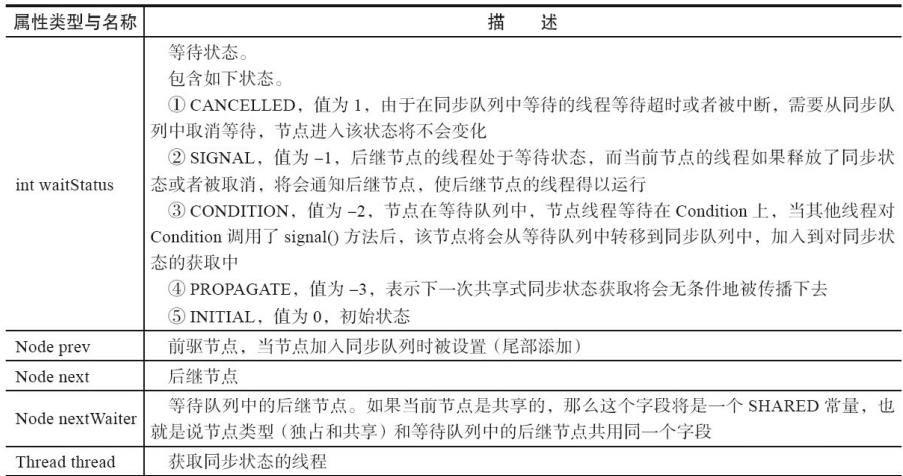
- 节点是构成队列的基础,有首尾节点。如果线程没有获取同步状态成功就会进入到队列的尾部
- 加入到尾部的时候一定要是一个线程安全的状态,所以有方法compareAndSetTail(Node expect,Node update)。
- 每次唤醒都是先从头部开始。
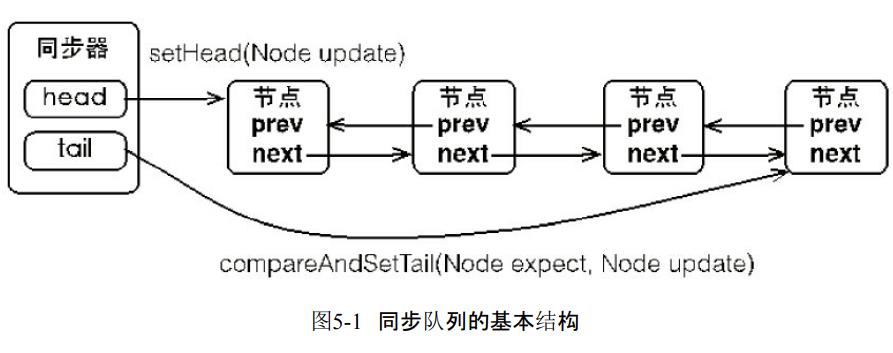
2.独占式同步状态获取与释放
- 同步器acquire(int arg)可以去获取同步状态。对中断不敏感。也就是线程不会从同步队列中移出去。
- 首先是调用tryAcquire(int arg)保证线程安全获取同步状态。
- 如果失败构造同步节点Node.EXCLUSIVE,并且通过addWaiter(Node node)加入到同步队列的尾部。
- 再通过acquireQueued(Node node,int arg)进入死循环获取同步状态。
- 只有前驱的节点头才能够获取同步状态
- 头结点获取同步状态的节点,释放之后会唤醒下一个节点
- 维护FIFO原则。
public final void acquire(int arg)
if (!tryAcquire(arg) &&
acquireQueued(addWaiter(Node.EXCLUSIVE), arg))
selfInterrupt();
- compareAndSetTail(Node expect,Node update)保证了节点线程安全加入。enq通过死循环保证节点被正确添加。
private Node addWaiter(Node mode)
Node node = new Node(Thread.currentThread(), mode);
// 快速尝试在尾部添加
Node pred = tail;
if (pred != null)
node.prev = pred;
if (compareAndSetTail(pred, node))
pred.next = node;
return node;
enq(node);
return node;
private Node enq(final Node node)
for (;;)
Node t = tail;
if (t == null) // Must initialize
if (compareAndSetHead(new Node()))
tail = head;
else
node.prev = t;
if (compareAndSetTail(t, node))
t.next = node;
return t;
- acquireQueued(final Node node,int arg)死循环获取同步状态。
final boolean acquireQueued(final Node node, int arg)
boolean failed = true;
try
boolean interrupted = false;
for (;;)
final Node p = node.predecessor();
if (p == head && tryAcquire(arg))
setHead(node);
p.next = null; // help GC
failed = false;
return interrupted;
if (shouldParkAfterFailedAcquire(p, node) &&
parkAndCheckInterrupt())
interrupted = true;
finally
if (failed)
cancelAcquire(node);
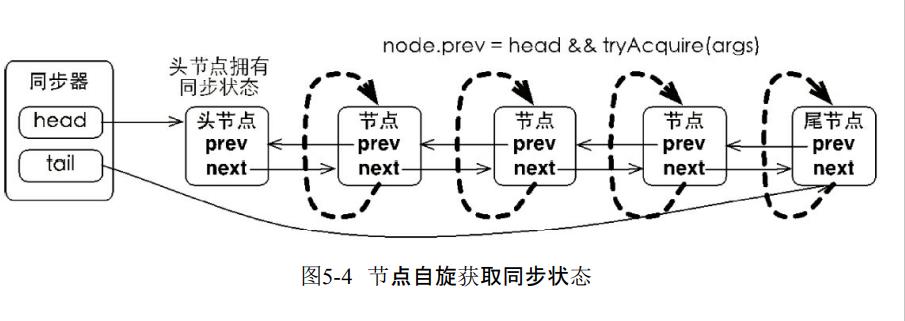
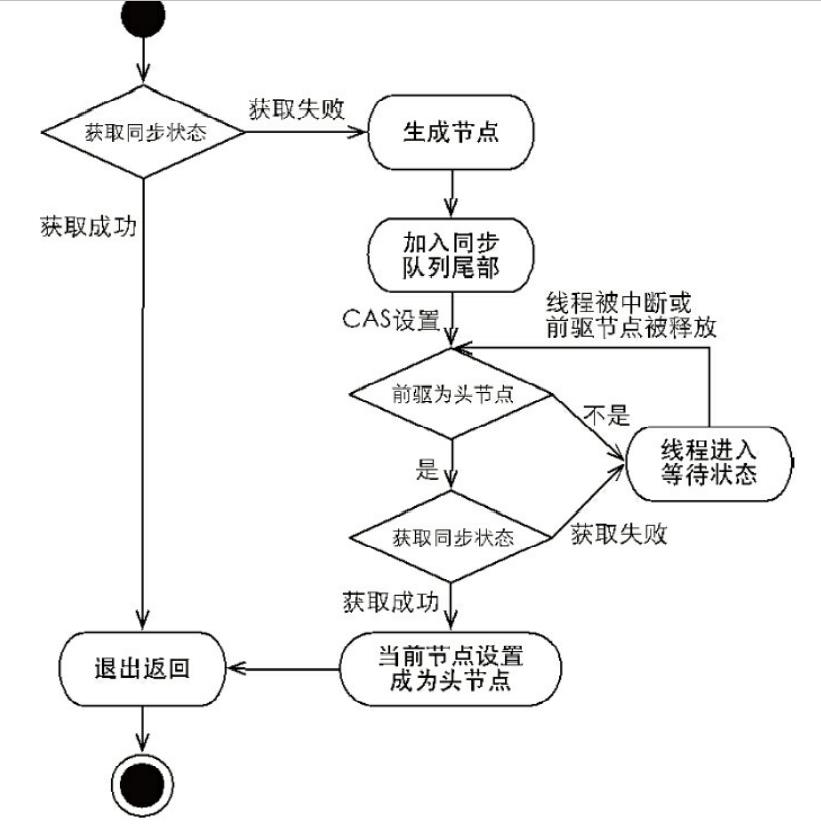
- 接着就是release,唤醒头结点后面的一个节点
3.共享式同步状态获取与释放
- 共享锁可以多线程获取同步状态。
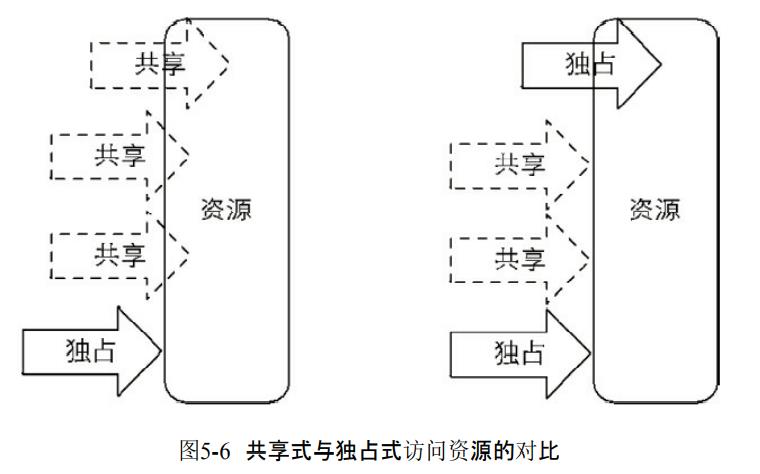
- acquireShared(int arg)共享式获取同步状态。
- 同步器调用tryAcquireShared(int arg)来获取同步状态,返回值大于等于0说明获取成功。
public final void acquireShared(int arg)
if (tryAcquireShared(arg) < 0)
doAcquireShared(arg);
private void doAcquireShared(int arg)
final Node node = addWaiter(Node.SHARED);
boolean failed = true;
try
boolean interrupted = false;
for (;;)
final Node p = node.predecessor();
if (p == head)
int r = tryAcquireShared(arg);
if (r >= 0)
setHeadAndPropagate(node, r);
p.next = null;
if (interrupted)
selfInterrupt();
failed = false;
return;
if (shouldParkAfterFailedAcquire(p, node) &&
parkAndCheckInterrupt())
interrupted = true;
finally
if (failed)
cancelAcquire(node);
4.独占式超时获取同步状态
- 可以通过调用同步器的doAcquireNanos(int arg,long nanosTimeout)可以超时获取同步状态。
- 如果是调用了acquireInterruptibly(int arg),那么只要线程被中断就会报InterruptedException。
- 但是doAcquireNanos(int arg,long nanosTimeout)能够中断,而且可以计算出需要睡眠的时间。nanosTimeout-=now-lastTime如果是大于0说明还没有超时。否则就是超时了。
- 如果 nanosTimeout小于等于spinForTimeoutThreshold(1000纳秒)的时候,线程就不会进入到超时等待了。而是进入到快速自旋。直到超时。
private boolean doAcquireNanos(int arg, long nanosTimeout)
throws InterruptedException
long lastTime = System.nanoTime();
final Node node = addWaiter(Node.EXCLUSIVE);
boolean failed = true;
try
for (;;)
final Node p = node.predecessor();
if (p == head && tryAcquire(arg))
setHead(node);
p.next = null; // help GC
failed = false;
return true;
if (nanosTimeout <= 0)
return false;
if (shouldParkAfterFailedAcquire(p, node)
&& nanosTimeout > spinForTimeoutThreshold)
LockSupport.parkNanos(this, nanosTimeout);
long now = System.nanoTime();
//计算时间,当前时间now减去睡眠之前的时间lastTime得到已经睡眠
//的时间delta,然后被原有超时时间nanosTimeout减去,得到了
//还应该睡眠的时间
nanosTimeout -= now - lastTime;
lastTime = now;
if (Thread.interrupted())
throw new InterruptedException();
finally
if (failed)
cancelAcquire(node);
5.3 重入锁
- 支持一个线程多次获取锁。
- 公平锁效率未必比非公平的高。
1.实现重进入
- 线程再次获取锁,需要锁去识别当前获取锁的线程是不是和锁的持有线程一样。
- 锁的释放,要求的就是计数重复获取锁的数量减低为0。
- 下面的方法就增加了线程的判断。增加了同步状态的值。
final boolean nonfairTryAcquire(int acquires)
final Thread current = Thread.currentThread();
int c = getState();
if (c == 0)
if (compareAndSetState(0, acquires))
setExclusiveOwnerThread(current);
return true;
else if (current == getExclusiveOwnerThread())
int nextc = c + acquires;
if (nextc < 0)
throw new Error("Maximum lock count exceeded");
setState(nextc);
return true;
return false;
- 同样要求在释放的时候,减去状态的值。
protected final boolean tryRelease(int releases)
int c = getState() - releases;
if (Thread.currentThread() != getExclusiveOwnerThread())
throw new IllegalMonitorStateException();
boolean free = false;
if (c == 0)
free = true;
setExclusiveOwnerThread(null);
setState(c);
return free;
2.公平与非公平获取锁的区别
- 锁是公平那么一定符合FIFO请求的绝对时间顺序。
- 对于非公平锁来说只要CAS成功,那么就算是同步状态成功。
- 对于公平锁,每次获取锁的时候还需要判断队列是不是有线程等待,才能够获取。
protected final boolean tryAcquire(int acquires)
final Thread current = Thread.currentThread();
int c = getState();
if (c == 0)
if (!hasQueuedPredecessors() && compareAndSetState(0, acquires))
setExclusiveOwnerThread(current);
return true;
else if (current == getExclusiveOwnerThread())
int nextc = c + acquires;
if (nextc < 0)
throw new Error("Maximum lock count exceeded");
setState(nextc);
return true;
return false;
- 非公平锁只要CAS状态成功就算是获取锁,所以可能会导致一个线程连续获取锁。
- 而且公平锁每次获取锁的线程不同每次都要切换,但是非公平锁可以连续一个线程获取锁,减少切换的成本。
5.4 读写锁
- 读写锁允许同一个时刻多个读线程访问。
- 读写锁维护了一对锁。
- ReentrantReadWriteLock的特性
- 公平性选择:支持公平和非公平获取
- 可重入
- 锁降级
5.4.1 读写锁的接口与示例

5.4.2 读写锁的实现分析
1.读写状态的设计
- 同样是依靠同步器实现同步的功能。
- 维护读写锁的同步状态有多个状态。所以通过按位切割使用。高16位是读,低16位是写。
- 当前的同步状态是读锁被同一个线程获取了写锁,重入了两次,而且还获取了两次读锁。
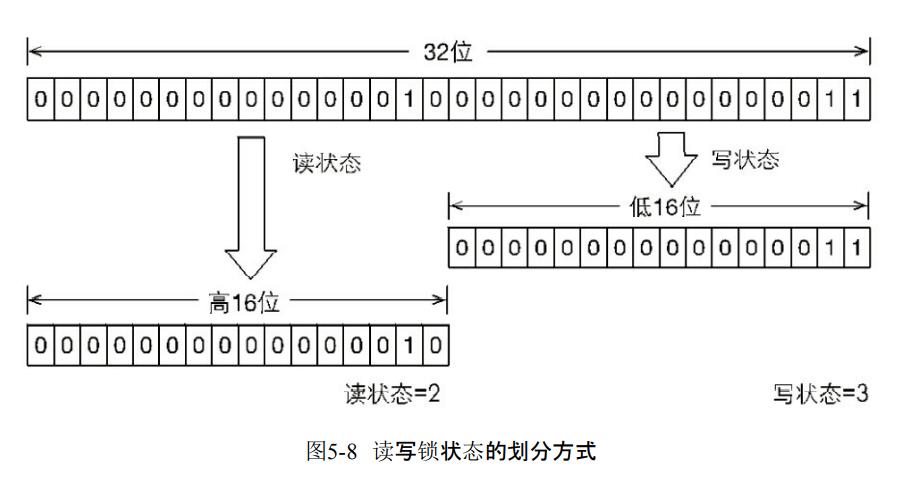
2.写锁的获取与释放
-
写锁是支持可重入的排它锁。
-
如果当前线程获取了写锁,那么就增加写状态,如果当前线程在获取写锁时,读锁已经被获取或者该线程不是已经获取写锁的线程,那么线程进入到等待状态。
-
这里除了判断可重入,还判断是否存在读锁。如果存在读锁,那么写锁就不能被获取。
-
因为读写锁需要保证写锁的操作对读锁是可见的。因为读锁被获取的状况,去获取写锁,那么当前运行的线程是没有办法感知当前写线程的操作。
protected final boolean tryAcquire(int acquires)
Thread current = Thread.currentThread();
int c = getState();
int w = exclusiveCount(c);
if (c != 0)
// 存在读锁或者当前获取线程不是已经获取写锁的线程
if (w == 0 || current != getExclusiveOwnerThread())
return false;
if (w + exclusiveCount(acquires) > MAX_COUNT)
throw new Error("Maximum lock count exceeded");
setState(c + acquires);
return true;
if (writerShouldBlock() || !compareAndSetState(c, c + acquires))
return false;
setExclusiveOwnerThread(current);
return true;
3.读锁的获取与释放
- 支持可重入的共享锁。
- 能被多个线程获取,在没有别的写线程访问的情况下,读锁会被成功获取。
- 如果当前线程已经获取了读锁,那么就增加读状态。
- 如果当前线程获取读锁的时候,发现写锁被获取,那么就会进入到等待状态。
protected final int tryAcquireShared(int unused)
for (;;)
int c = getState();
int nextc = c + (1 << 16);
if (nextc < c)
throw new Error("Maximum lock count exceeded");
if (exclusiveCount(c) != 0 && owner != Thread.currentThread())
return -1;
if (compareAndSetState(c, nextc))
return 1;
4.锁降级
- 锁降级指的是写锁降级成为读锁。意思是拿到写锁之后再获取读锁
- 锁降级的获取读锁是否有必要?如果不获取读锁,直接释放写锁的问题就是另一个线程获取写锁并且修改数据,那么当前线程无法感知线程T的数据更新。
5.5 LockSupport工具

- park(Object blocker)、parkNanos(Object blocker,long nanos) 和parkUntil(Object blocker,long deadline)阻塞当前线程,blocker是标识线程等待的对象。
5.6 Condition接口
5.6.2 Condition的实现分析
1.等待队列
- 是一个FIFO队列。如果线程调用await就会进入Condition的等待队列。
- 由于await一定是在获取锁的情况执行,所以不需要CAS保证线程安全性。

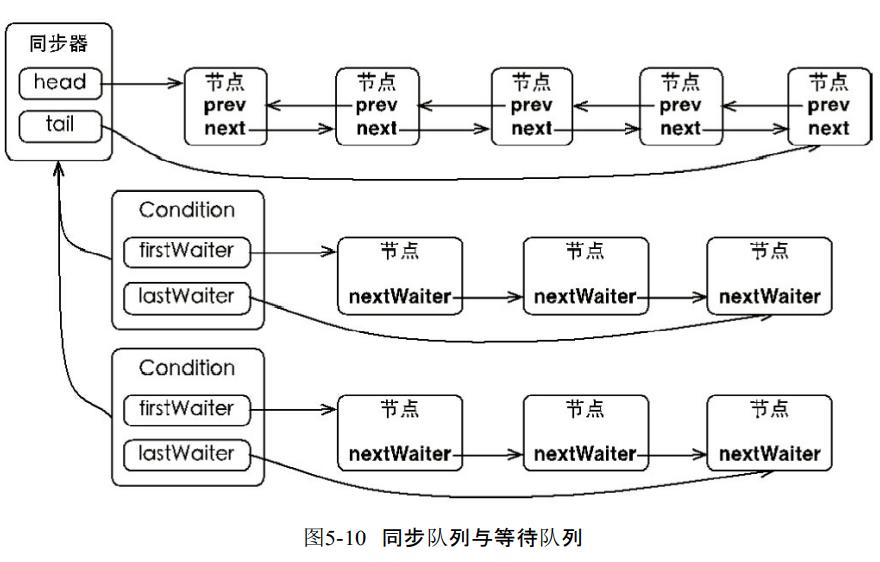
2.等待
- 释放锁,并且线程进入到等待队列。
public final void await() throws InterruptedException
if (Thread.interrupted())
throw new InterruptedException();
// 当前线程加入等待队列
Node node = addConditionWaiter();
// 释放同步状态,也就是释放锁
以上是关于Java并发编程的艺术(5-10)学习总结的主要内容,如果未能解决你的问题,请参考以下文章